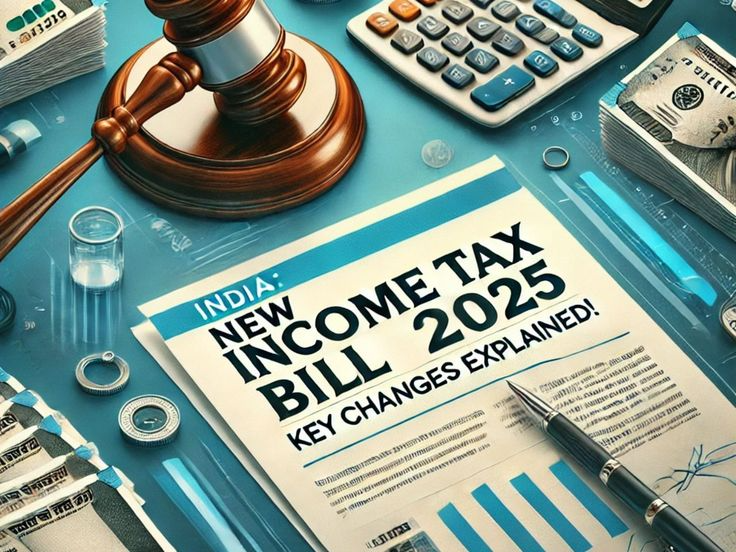What’s New: Income-Tax Bill, 2025

Background & Legislative Timeline
- The original Income-tax Bill, 2025 was introduced in the Lok Sabha on February 13, 2025, aiming to replace the 1961 Act with a streamlined and digital-friendly structure; it featured 536 sections across 16 schedules and emphasized simplified language and faceless assessments
- After review by a Parliamentary Select Committee (report submitted July 21, 2025), the government withdrew the bill on August 8, incorporating most of the committee’s recommendations
- The revised Income-Tax (No. 2) Bill, 2025 was introduced and passed by the Lok Sabha on August 11, 2025, in a largely noisy session, achieving both simplification and enhanced fairness
Key Features of the Revised Bill
1. Tax Structure & Rebates
- Under the new tax regime effective FY 2025–26, individuals with taxable income up to ₹12 lakh are exempt from paying income tax, especially after factoring in the raised standard deduction of ₹75,000, effectively raising the no-tax threshold to ₹12.75 lakh
- Updated tax slabs under the new regime:
- Nil: up to ₹4 lakh
- 5%: ₹4–₹8 lakh
- 10%: ₹8–₹12 lakh
- 15%: ₹12–₹16 lakh
- 20%: ₹16–₹20 lakh
- 25%: ₹20–₹24 lakh
- 30%: above ₹24 lakh
- The Section 87A rebate is substantially increased:
- Taxpayer with income up to ₹5 lakh gets a 100% rebate or ₹12,500, whichever is less NewTaxRegime.
2. Homeowner & Property-Related Provisions
- Annual value of property is the higher of expected rent or actual rent received (minus municipal taxes), with “realizable rent” excluded.
- Clarification under Clause 22 gives homeowners a 30% standard deduction from the property’s annual value. Interest from a pre-construction home loan is allowed to be claimed in five equal installments post-construction
3. Pension Relief & Definitions
- Full tax deduction for commuted pension received from specified pension funds (e.g., LIC Pension Fund, NPS) is now explicitly allowed—benefiting both salaried and self-employed pensioners
- The definition of “relative” is clarified to include both maternal and paternal lineal ascendants and descendants, eliminating previous ambiguity in gift-tax provisions
4. Taxpayer-Friendly Measures
- The revised bill includes provisions to waive penalties for honest, inadvertent errors, reflecting a more taxpayer-friendly stance in encouraging compliance
- It also continues the modernization push: simplifying chapters (from 29 to 23), promoting digital processes, and removing outdated clauses income tax slab 2025
Summary & Writing Tips for Your Blog
Structure your post with clear headings—such as Overview, Key Changes, and Why It Matters—to enhance readability.
Use plain, reader-friendly writing, avoiding legal jargon.
Back up each point with a brief note on why it matters—e.g., “Raise in exemption reduces tax burden for middle-class families penalty waiver for taxpayers India.”
Maintain originality by paraphrasing—express all details in your own words.
Add a conclusion capturing how this bill marks a landmark shift toward simplified, equitable taxation.
New Updates & Highlights
1. Simplified Tax Code & Structural Reform
- The revised bill slashes the complexity of India’s tax law by nearly 50%, replacing the archaic 1961 Act with clearer, streamlined legislation. The new draft consolidates more than 500,000 words into a more manageable structure, easing compliance for individuals, MSMEs, and small businesses.
- It also establishes a unified ‘tax year’, replacing the ‘assessment year’ and ‘previous year’ terms—particularly aiding new businesses and income sources.
2. Tax Administration & Digital Enforcement
- The government retains—and modernizes—anti-evasion provisions: authorities can access digital platforms like email servers, social media, and online trading accounts during searches. The revamped bill now explicitly authorizes virtual searches in digital realms.
- 3. House Property Provisions
- Clause 22 now clearly allows homeowners a 30% standard deduction from the house property’s annual value to account for maintenance-related costs, regardless of actual expenditure.
3. Enhanced Rebate & Relief
- Marginal relief continues for those just exceeding the limit.
- Honest taxpayer errors will no longer attract penalties—this taxpayer-friendly stance is aimed at promoting voluntary compliance house property tax rules 2025
.
4. Legislative Journey
- The bill was introduced and passed in the Lok Sabha on August 11, 2025, but amid considerable uproar—with little debate. Government officials reaffirm that all key recommendations from the Select Committee, led by Baijayant Panda, have been incorporated.
At a Glance: Highlights Table
| Area | Key Update |
|---|---|
| Tax Structure | Simplified code; unified tax year |
| Digital Enforcement | Includes virtual/digital access for tax authorities |
| House Property | 30% standard deduction; phased pre-construction interest deduction |
| Pension | Full tax deduction for commuted pension from eligible funds new tax regime India |
| Rebate & Relief | 87A rebate threshold ↑ to ₹12 lakh; no penalty for genuine errors |
| Legislative Process | Passed quickly on Aug 11; key Select Committee suggestions accepted |
Blogging Suggestions
- Break it into sections like Overview, Key Revisions, How It Helps Taxpayers, and Legislative Milestones for clarity.
- Add value by comparing it to the old system—especially for homeowners or pensioners.
- Use analogies and real-life examples—like showing how the deductions or rebate work for someone earning ₹10 lakh.
- End with impact—such as how the bill underscores India’s push toward a modernized, fair, and transparent tax regime section 87A rebate 2025.



